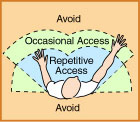
|
 |
Hospital eTool
Administration Module
Click on the area for more specific information.

|
Common safety and health topics:
 Safety and Health Program Safety and Health Program |
|
Potential Hazard
- OSHA has concluded that effective management of worker safety and health is a decisive factor in reducing the extent and the
severity of work-related injuries and illnesses. Effective management addresses all work-related hazards, including those potential
hazards that could result from a change in worksite conditions or practices. It addresses hazards whether or not they are regulated
by government standards.
OSHA's experience in the Voluntary Protection Program
has also indicated that effectively managing safety and health protection programs improve employee morale and productivity, as well as significantly reduce
workers' compensation costs and other less obvious costs of work-related injuries and illnesses.
Additional Information:
|
 Regulatory Agencies Regulatory Agencies |
|
Potential Hazard
-
Health Care Financing Administration (HCFA)
- The Health Care Financing Administration (HCFA) is a federal agency within the U.S. Department of Health and Human Services.
HCFA runs the Medicare and Medicaid programs — two national health care programs that benefit about 75 million Americans. The
HCFA and the Health Resources and Services Administration, run the Children’s Health Insurance Program, a program that is expected
to cover many of the approximately 10 million uninsured children in the United States.
- HCFA also regulates all laboratory testing (except research) performed on humans in the United States. Approximately 158,000 laboratory
entities fall within HCFA’s regulatory responsibility. HCFA, with the Departments of Labor and Treasury, help millions of Americans
and small companies get and keep health insurance coverage and help eliminate discrimination based on health status for people buying health
insurance.
- Joint Commission on Accreditation of Healthcare Organizations (JCAHO)
- The mission of JCAHO is to continuously improve the safety and quality of care provided to the public through the provision of health
care accreditation and related services that support performance improvement in health care organizations.
- The Joint Commission evaluates and accredits more than 19,500 health care organizations in the United States, including hospitals, health care networks,
managed care organizations, and health care organizations that provide home care, long term care, behavioral health care, laboratory, and ambulatory care
services. The Joint Commission is an independent, not-for-profit organization, and the world's leading health care standards-setting and accrediting body.
- The Centers for Disease Control and Prevention (CDC)
- The CDC is recognized as the lead federal agency for protecting the health and safety of people - at home and abroad, providing credible
information to enhance health decisions, and promoting health through strong partnerships. The CDC serves as the national focus for developing and applying
disease prevention and control, environmental health, and health promotion and education activities designed to improve the health of the people of the
United States.
- The National Institute for Occupational Safety and Health (NIOSH)
- NIOSH is the Federal agency responsible for conducting research and making recommendations for the prevention of work-related disease and injury. The
Institute is part of the (CDC).
- NIOSH is responsible for conducting research on the full scope of occupational disease and injury ranging from lung disease in miners to carpal tunnel
syndrome in computer users. In addition to conducting research, NIOSH: investigates potentially hazardous working conditions when requested by employers or
employees; makes recommendations and disseminates information on preventing workplace disease, injury, and disability; and provides training to occupational
safety and health professionals.
- The College of American Pathologists (CAP)
- The mission of CAP, the principal organization of board-certified pathologists, is to represent the interests of patients, the public, and pathologists
by fostering excellence in the practice of pathology and laboratory medicine worldwide.
- The College of American Pathologists is a medical society serving more than 15,000 physician members and the laboratory community throughout
the world. It is the world's largest association composed exclusively of pathologists and is widely considered the leader in providing laboratory quality
improvement programs.
- The American College of Radiology (ACR)
- The ACR is the principal organization of radiologists, radiation oncologists, and clinical medical physicists in the United States. The college
is a nonprofit professional society whose primary purposes are to improve service to the patient, advance the science of radiology, study the socioeconomic
aspects of the practice of radiology, and encourage continuing education for radiologists, radiation oncologists, medical physicists, and persons practicing
in allied professional fields.
- National Fire Protection Association (NFPA)
- NFPA is a worldwide leader in providing fire, electrical, and life safety to the public. Established in 1896, this nonprofit, member organization's
mission is to reduce the worldwide burden of fire and other hazards on the quality of life by developing and advocating scientifically based consensus
codes and standards, research, training, and education. NFPA is currently developing the first consensus-based building code. Membership in NFPA totals
more than 67,000 individuals from around the world and more than 80 national trade and professional organizations.
|
 Trade Organizations Trade Organizations
|
|
Potential Hazard
- The American Society for Healthcare Engineering (ASHE) is the professional society
that represents individuals responsible for the environment of care used in healthcare delivery. The membership is served by providing leadership through
education and advocacy.
- The American Hospital Association (AHA) is the national organization that represents
and serves all types of hospitals, health care networks, and their patients and communities. Close to 5,000 institutional, 600 associate, and 40,000 personal
members come together to form the AHA.
- The American Society for Healthcare Risk Management (ASHRM) is the preeminent
society for healthcare risk management. This professional organization strives to advance risk management in the healthcare field through professional
development, membership services, enhanced communications, risk management innovation, and effective governance.
- The Association for Professionals in Infection Control and Epidemiology, Inc.
(APIC) is a multi-disciplinary voluntary international organization with over 10,000 members. Its purpose is to influence, support, and improve the quality
of healthcare through practicing and managing infection control and applying epidemiology in all health settings. The organization, which is based in
Washington, DC, is led by an elected board of members who volunteer their time and expertise.
|
 Admissions and Records Admissions and Records
|
|
Potential Hazard
Possible Solutions
- Redesign or lower filing cabinets so they can be reached while maintaining the elbows in close to the body.
- Powered filing cabinets that move to any height.
- Use ladders or stools to access high files rather than reaching overhead. For additional information, see
Computer Workstations Section.
|
 Computer Workstations Computer Workstations
|
|
Potential Hazard
- Employee's who use a computer (e.g., admittance area, data entry clerk, secretary) intensively for 4 hours or more per day, can develop
musculoskeletal disorders (MSD) of the hand/arm, shoulder, neck, and back.
Possible Solutions
- Look at the workstation layout and:
- Arrange materials and supplies in front of the body so they can be easily reached with the elbows in close to the torso.
- Provide adjustable, supportive padded chairs, that support the forearms, legs, and low back. Arm rests should allow the
elbows to hang normally at the side of the body.
- Arrange Monitor so that the most commonly viewed area is slightly below, (about 20 degrees), horizontal eye level and can be
seen without looking up, or leaning forward.
- Provide engineering controls to limit awkward positions, (e.g., provide head sets for employees to use when answering phones).
- Use a keyboard, which includes an adjustable mouse support that can be easily reached from a keying position. Employees should
keep wrists straight while typing and use wrist pads to rest on when not typing.
|

Keep most work activities within repetitive access area.

Maintain straight wrist postures.

Adjustable keyboard/mouse tray. |
Additional Information:
|
 Carbonless Paper Carbonless Paper |
|
Potential Hazard
- Employee exposure to carbonless paper. Carbonless paper is used everyday for checks, credit-card receipts and medical forms. Tiny micro granules
of dyes and resins are released when sheets are pressed together. The released chemicals can be absorbed through the skin or released into the air and
inhaled resulting in mild to moderate symptoms of skin irritation and irritation of the mucosal membranes of the eyes and upper respiratory tract.
Symptoms include: headaches, sinus infections, bronchitis, eye and skin irritations. Some rare cases of allergic contact dermatitis have also been
reported. Symptoms include shortness of breath and hives.
Possible Solutions
- NIOSH suggests in most cases, good industrial hygiene and work practices should be adequate to reduce or eliminate symptoms including:
- Adequate ventilation, humidity, and temperature controls
- Proper housekeeping
- Minimal hand-to-mouth and hand-to-eye contact; and periodic cleansing of hands
- These recommendations are similar to ones that have been made by other researchers, programs, and agencies in the U.S. and abroad.
Additional Information:
- Carbonless Copy
Paper NIOSH Publication No. 2001-107 (2000, December), 155 pages, 1,042K PDF. This NIOSH report reviews current scientific information
on health effects associated with occupational exposure to carbonless copy paper and recommends ways to reduce or eliminate symptoms.
|
 Employee/Employer Rights Employee/Employer Rights
|
|
Potential Hazard
- Employers and employees are not aware of their rights related to workplace safety.
Possible Solutions
|
 Recordkeeping Recordkeeping
|
According to the OSH Act of 1970 "each
employer shall make, keep and preserve, and make available to the Secretary or the Secretary of Health, Education, and Welfare, such records regarding his
activities relating to this Act as the Secretary, in cooperation with the Secretary of Health, Education, and Welfare, may prescribe by regulation as necessary
or appropriate for the enforcement of this Act or for developing information regarding the causes and prevention of occupational accidents and illnesses." |
Potential Hazard
- Employers not maintaining records that help:
- Document trends in illness and injury.
- Develop information regarding the causes and prevention of occupational accidents and illnesses.
Possible Solutions
- Comply with OSHA Recordkeeping Standards:
- The new Recordkeeping Rule
went into effect January 1, 2002.
-
1904, Recording and Reporting Occupational Injuries and Illnesses.
- Recordkeeping forms
OSHA Form 300, Log of Work-Related Injuries and
Illnesses has been revised and is now available on OSHA's website.
The forms, which are required for employers to use in recording injuries and
illnesses, have changed in several important ways for 2004.
Foremost among the changes is the addition of an occupational hearing loss
column to OSHA's Form 300, Log of Work-Related Injuries and Illnesses. Other
changes include:
- "days away from work" column now comes before the days
"on job transfer or restriction"
- more clear formulas for calculating incidence rates
- new recording criteria for occupational hearing loss in the
"Overview" section;
- more prominent column heading "Classify the Case" to make it
clear that employers should mark only one selection among the four columns
offered.
These changes were made in response to public
suggestions. For more information see the OSHA Trade News Release 10/02/2003.
-
Recordkeeping Rule OSHA Fact Sheet.
-
Recordkeeping Policies and Procedures Manual. CPL 2-0.131, (2002, January 1).
|
|

